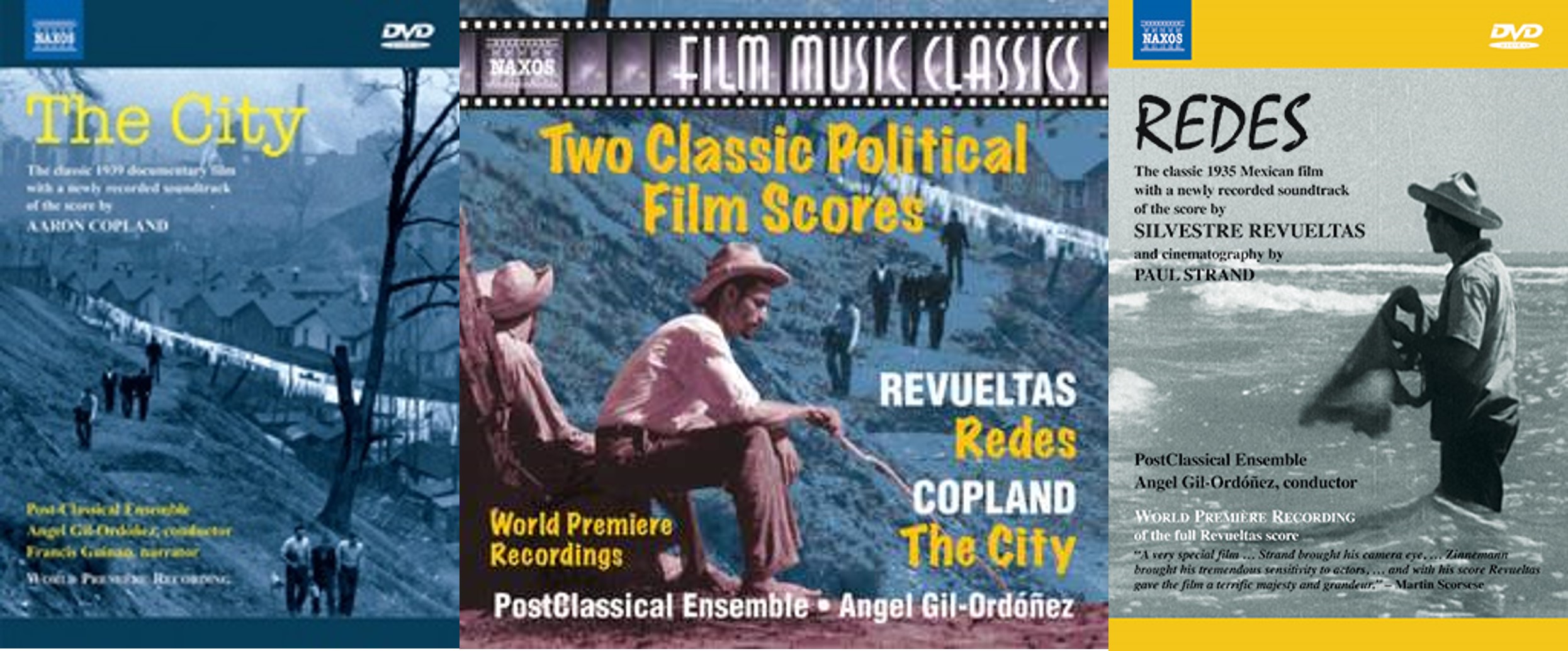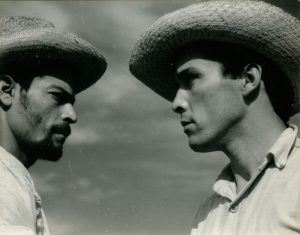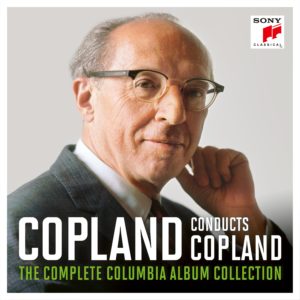
Sometimes you get what you want and sometimes you get what you ask for! Way back in 2009, Naxos released a DVD of The City the legendary documentary film from 1939 which was Aaron Copland’s first foray into movie scoring. It came with a newly recorded soundtrack performed by Post Classical Ensemble conducted by Angel Gil-Ordóñez. This was a really important release and was part of the renaissance in understanding and appreciation of Copland’s movie music. At around the same time Naxos also provided the same treatment for Virgil Thompson’s The River and The Plow that Broke the Plains but, whereas the latter were made available as DVD and separate CD, the CD release of the full soundtrack to The City was never forthcoming.
Way back in 2009, Naxos released a DVD of The City the legendary documentary film from 1939 which was Aaron Copland’s first foray into movie scoring. It came with a newly recorded soundtrack performed by Post Classical Ensemble conducted by Angel Gil-Ordóñez. This was a really important release and was part of the renaissance in understanding and appreciation of Copland’s movie music. At around the same time Naxos also provided the same treatment for Virgil Thompson’s The River and The Plow that Broke the Plains but, whereas the latter were made available as DVD and separate CD, the CD release of the full soundtrack to The City was never forthcoming.
For a while now I have been in touch with the founders of PCE – Angel Gil-Ordóñez and Joseph Horowitz (as a result of their other recent works Dvořák’s Prophecy: A New Narrative for American Classical Music). In Jan 2021 I wrote to them saying:
I wonder if it (The City) could be put on Spotify? It’s such a great score. The Eos Orchestra recorded a suite version but that’s not on Spotify either. I really think it would be worthwhile and could make Post Classical a few bucks perhaps?
One of the things that has happened over the last couple of decades is more of Copland’s film music has been released on CD. This has been a revelation. Far from being simply incidental music these scores really exemplify the craft for film music that Copland had, especially the ability to tell the unspoken thoughts of a character.
The release of the book on Copland film scores last year will also increase interest in this music. Therefore, it seems very strange that all the effort you put into recording this is only available to watch on DVD (which is a medium whose days are frankly numbered!). I really hope you may consider getting this work out there on to Spotify and other streaming services. It really deserves it!
I got the response from PCE that I was definitely preaching to the choir and that they had asked Naxos countless times for the CD to be released. Nevertheless, they forwarded my comments to Naxos and then a few days later came back to me with the happy news that Naxos had agreed and would release The City as a CD that October! In fact, it was finally released in March 2022 alongside Redes (another influential film from 1935 about poor Mexican fishermen who rise up against their paymasters) with a score by Silvestre Revueltas.
These are both incredible scores – truly ground-breaking and now finally getting the wider audience that they deserve.
Redes – I love the soundtrack but not so sure about the film
I wasn’t familiar with Redes or much of the music of Revueltas before I listened to this soundtrack. I am not alone. He is described in the liner notes as ‘Mexico’s most famous unknown composer’. I also acquired the DVD so I could watch the film as well. Based on the description of Revueltas as a populist and a political composer and quite different from Copland the arch modernist I was not expecting to hear so many similarities and so much dissonance!
The Introduction with its strident motif and stinger chords reminds me a lot of the overture to Hangmen also Die scored by Hans Eisler in 1943. There’s plenty of pathos too. The cues Palms and Huts and Funeral deal with the poverty of the fishermen and the death of the main character’s sick child who requires medical help but whose appeals are brushed aside. It’s interesting to hear how Revueltas and Copland deal with similar melancholy themes. Compare these to Copland’s Steeltown II and the opening of The City II where kids are choking in the noxious fumes next of the Pittsburgh steel mill and playing in the gutters in New York.
The most instantly accessible piece is Good Fishing. This accompanies the sudden appearance of a shoal of fish and the Mexican dance rhythms are perfect for the excitement and eagerness to make the catch. However, throughout this six and half minutes of joy there are frequent intersections where a lone trumpet or combination of percussion and brass introduce a discordance that completely counters this feeling of exuberance. To me it gives the impression of distinctive nagging doubt in the back of the fishermen’s minds that despite the glut of fish that they will still have to rely on a good market price from middlemen. As they are price takers, at the bottom of the food chain, there is every chance that they will be ripped off yet again and of course this inevitably turns out to be the case.
The sound of the dance hall in Good Fishing makes for an obvious comparison with Copland’s El Salon Mexico (written in 1933). However, what I wasn’t expecting to hear was a clear similarity with Copland’s magnum opus Symphonic Ode! The dramatic cues Nets and first half of Fighting-Unity have the same jolting and jarring cross rhythms and declamatory climaxes as the third part of the Ode – Subito Allegro (means immediately fast). Have a listen to the John Wilson, BBC Philharmonic version to see what I mean. You can understand why these clear stylistic similarities appealed to Copland. In his New York Times review of Redes he compares Revueltas to Schubert and wrote:
“[The] music is above all vibrant and colourful”
His music is a spontaneous outpouring, a strong expression of his inner emotions. There is nothing premeditated about him”
However, in other writings he would also damn Revueltas with faint praise. In a letter to Arthur Berger in 1944 (four years after Revuelta’s untimely death at the age of 40) Copland wrote:
He was like a modern painter who throws marvellous daubs of color on canvas that practically takes your eye out, but it doesn’t add up. Too bad- because he was a gifted guy”
It is likely that most critics thought much the same about Symphonic Ode. Probably also why I like both pieces so much!

Great still but the acting in Redes is like watching words being spoken by the granite Presidents of Mount Rushmore!
The music of Redes does stand alone on its own and there are some very enjoyable cues throughout including a terrific finale (more on that later) . I’m quite thankful for this CD as I’m not sure how many times I would be able to sit through Redes as a movie! It’s only an hour long and although I empathise with the poor fishermen and agree that the score and cinematography are superb, the acting is not! Unfortunately, the choice by the film makers to use all but one non-actor to perform in the film means that it often feels like you are watching words being spoken by the granite faces on Mount Rushmore! It therefore does come across as a period piece.
By contrast The City still works brilliantly as a film and the humorous elements and documentary nature with limited dialogue, make it watchable again and again.
The City – superb recording slightly let down by the engineering
Copland was a true original in his film scoring method. Prior to his emergence in this medium, scores were generally lushly orchestrated and it was rare for a single instrument to be heard on it’s own. With The City, Copland laid down an immediate marker with much more thoughtful orchestration providing opportunities for important supporting instrumental roles and solos particularly in the woodwinds.
The opening piece A New England Village (New England Countryside on the Celluloid Copland Telarc disc and in Music for Movies) is a case in point. It initially comes across as what most people would expect as typical Copland, in as much as it paints a sublime and bucolic scene. However, listen very closely and you’ll hear a very subtle but insistent long drawn out contra bassoon note at the end of many of the phrases e.g. 0:44 and 1:14. Similar to the juxtaposition in Good Fishing, this suggests to me that Copland was trying to imply that although, in an ideal world it would be wonderful for everyone to live in a rural idyll, this is simply not possible. I think, the contra bassoon is reminiscent of a ship horn and therefore immediately brings to mind boatful’s of immigrants heading into Ellis Island. As The City is all about how to sensitively accommodate and improve the lives of the masses I am pretty sure that this image created by Copland was intended.
It’s not easy to hear on disc so check out this YouTube clip of Music for Movies:
Later in A New England Village there is an absolutely gorgeous solo for the alto saxophone. Copland probably used this instrumentation to accentuate the Americanness of the music. When he later revamped this cue for inclusion in Music for Movies Copland uses a bassoon for this part, probably in order to achieve more concert performances by a regular orchestra. Unfortunately, this means that this lovely melody is often more hidden in CD versions. (Check out the Leonard Slatkin/Saint Louis Symphony Orchestra version which proves my point – it really does fade into the background whereas it is front and centre on the PCE release).
 There are many other inspired bits of orchestration – the lovely cor anglais for the sad themes (Steeltown II, The City II), the bass clarinet in The City II and New Town, the flute in the New Town cues and the ever present bass trombone in Sunday Traffic (at the end of The City II).
There are many other inspired bits of orchestration – the lovely cor anglais for the sad themes (Steeltown II, The City II), the bass clarinet in The City II and New Town, the flute in the New Town cues and the ever present bass trombone in Sunday Traffic (at the end of The City II).
Like Redes you can hear the influence of The City on the movie scores of others. The nightmare music Copland employs for the awful cheek by jowl, overcrowding, taxi jam and fast-food conveyor almost invents horror movie music. Listen  to The City I next to Bernard Herrmann’s Psycho score and you’ll get the picture. In the DVD liner notes Joseph Horowitz quotes Mark Swed who in an article in the Los Angeles Times called The City
to The City I next to Bernard Herrmann’s Psycho score and you’ll get the picture. In the DVD liner notes Joseph Horowitz quotes Mark Swed who in an article in the Los Angeles Times called The City
“an astonishing missing link not only in the genesis of Copland’s Americana style but in American music and cinema”.
This section with its rapid repeats of “minimalist musical shards” forecasts the music of Philip Glass and Steve Reich. Swed adds:
Copland never wrote like that before or after, yet these unknown pages are powerfully prescient of the most significant stylistic revolution in the last quarter century of American Music.”
As you would expect from Joseph Horowitz, the liner notes are excellent with one minor exception. He misses the opportunity to briefly compare The City with Copland’s last film, the independent feature Something Wild. As these are the only two films Copland scored with a New York setting and had similar themes (e.g. Subway Jam and Taxi Jam, scenes of overwhelming sadness Mary Ann Resigned and Steeltown I and and horror like music e.g. Incarceration and Nightmares) this would be worthy of note. Instead, he simply dismisses Something Wild as a film “populated by Manhattan beggars and whores” which is not only an unfortunate turn of phrase but also not correct. There is one possible sex worker but she plays only a very minor role in what is a psychological drama about a rape victim who is rescued from suicide and then imprisoned by the drunken mechanic who saves her.
The overall performance, production and sound quality of this CD are admirable. However, the engineering choices are somewhat of a let-down. It’s really puzzling that there are five musical cues for New Town (the shortest being 41 seconds long) whilst The City II is amalgamated into one cue lasting 11 minutes. There is ample opportunity to split these into more cues and it is especially odd considering that Sunday Traffic is almost certainly the most well-known music on the disc and the one that many listeners would want to play on its own.
This issue doesn’t just affect the Copland. The Finale of Redes could and should also be divided into more takes. The final two and a half minutes of the nine-minute length deserves to stand alone. It is a brooding theme that grows and grows to a loud and riveting crescendo.
As a result, this slightly lazy engineering turns a five star release and a five star performance into a four star listening experience which is a bit of shame. However, these are small issues as I would certainly much rather have this disc than not at all.
There will probably be hundreds of Bach, Beethoven Mozart CD releases this year. Most will probably plough very familiar ground and some, perhaps will be improvements on previous performances. By contrast this CD is something really special – world premiere recordings of two scintillating and revolutionary movie scores. I’ve said it several times before and I’ll say it again – Thankyou Post Classical Ensemble!









Blog Comments
Angel Gil-Ordóñez
28th August 2023 at 9:21 pm
Dear Kevin, this is fantastic. What an extraordinary article! Million thanks.
At least in the USA you can find the CD on Spotify
https://open.spotify.com/album/3eRvN91WbJW8ysYyJfNk0M?si=URWgQqXNSbeiqTG6LYjliA
Regarding your comment on the ship horn, If my memory doesn’t fail me, The City has no contrabassoon, just bassoon. I will take a look at the score and get back to you.
Million thanks again for your amazing support to our work.
My best regards, Angel